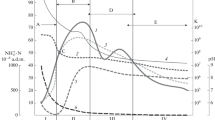Abstract
Two compost piles were prepared, using two ventilation systems: forced ventilation and ventilation through mechanical turning. The material to compost was a mixture of orange waste, olive pomace, and grass clippings (2:1:1 v/v). During the composting period (375 days), samples were periodically taken from both piles, and the enumeration of fungi, actinomycetes, and heterotrophic bacteria was carried out. All studied microorganisms were incubated at 25 and 55 °C after inoculation in appropriate growth media. Fungi were dominant in the early stages of both composting processes; heterotrophic bacteria proliferated mainly during the thermophilic stage, and actinomycetes were more abundant in the final stage of the composting process. Our results showed that the physical and chemical parameters: temperature, pH, moisture, and aeration influenced the variation of the microbial population along the composting process. This study demonstrated that composting of these types of wastes, despite the prolonged mesophilic stage, provided an expected microbial variation.





Similar content being viewed by others
References
Baddi GA, Alburquerque JA, Gonzálvez J, Cegarra J, Hafidi M (2004) Chemical and spectroscopic analyses of organic matter transformations during composting of olive mill wastes. Int Biodeterior Biodegrad 54(1):39–44. doi:10.1016/j.ibiod.2003.12.004
Baeta-Hall L, Sàágua MC, Bartolomeu ML, Anselmo AM, Rosa MF (2002) A compostagem como processo de valorização dos resíduos produzidos na extracção de azeite em contínuo. Biotecnologia Ambiental. Boletim de Biotecnologia 72:31–37
Bot A, Benitez J (2005) The importance of soil organic matter—key to drought resistant soil and sustained food production. FAO Soil Bull 80:78
Boulter JI, Boland GJ, Trevors JT (2000) Compost: a study of the development process and end-product potential for suppression of turfgrass disease. World J Microb Biot 16:115–134. doi:10.1023/A:1008901420646
Coelho L, Reis M, Dionísio L (2011) Culture media performance on the detection of actinomycetes from composts. Abstracts Book. International Symposium on Growing Media, Composting and Substrate Analysis:170. October 17–24. Barcelona, Spain
Cunha-Queda AC, Cordeiro A, Ferreira J, Nunes M, Coelho C, Wiersma HL, Correia de Oliveira J, Brandão de Menezes J (2005) Compostagem de resíduos agro-industriais para fertilização de culturas hortícolas e olival em agricultura biológica. Actas Portuguesas de Horticultura 7(3):275–281
Day M, Shaw K (2005) Procesos biológicos, químicos, físicos del compostaje. In: Stollella P, Kahn B (eds) Utilización de compost en sistemas de cultivo hortícola. Ediciones Mundi-Prensa. p 17-50
Finstein MS, Morris ML (1975) Microbiology of municipal solid waste composting. Adv Appl Microbiol 19:113–151. doi:10.1016/S0065-2164(08)70427-1
Gabriels R, Verdonck O (1991) Physical and chemical characterization of plant substrates: towards a European standardization. Acta Horticulturae 294:249–259
Golueke CG (1972) Composting: a study of the process and its principles. Rodale, Emmaus
Goodfellow M, Willians ST (1983) Ecology of actinomycetes. Annu Rev Microbiol 37:189–216. doi:10.1146/annurev.mi.37.100183.001201
Goyal S, Dhull SK, Kapoor KK (2005) Chemical and biological changes during composting of different organic wastes and assessment of compost maturity. Bioresour Technol 96:1584–1591. doi:10.1016/j.biortech.2004.12.012
Lacey J (1973) Actinomycetes in soils, composts and fodders. In: Sykes G, Skinner FA (eds) Actinomycetales: characteristics and practical importance. Academia, New York, pp 231–251
Martin DL, Gershuny G (1992) The rodale book of composting. Rodale, Emmaus
Martinez FX (1992) Propuesta de metodología para la determinación de las propriedades fisicas de los substratos. Actas de las I Jornadas de Substratos de la SECH 294:55–65
McCarthy AJ, Williams ST (1992) Actinomycetes as agents of biodegradation in the environment—a review. Gene 115:189–192. doi:10.1016/0378-1119(92)90558-7
Nakasaki K, Sasaki M, Shoda M, Kubota H (1985) Change in microbial numbers during thermophilic composting of sewage sludge with reference to CO2 evolution rate. Appl Environ Microb 49:37–41
Ramos JCM, Vilaseca JS, Ramon AC (1987) Control analític de la qualitat del compost i estudi de la seva maduració, p 31-69, In: Server del Medi Ambient, Diputació de Barcelona (eds) Experiències amb el compost. Estudis I monografies 12
Raut MP, Prince William SPM, Bhattacharyya JK, Chakrabarti T, Devotta S (2008) Microbial dynamics and enzyme activities during rapid composting of municipal solid waste—a compost maturity analysis perspective. Bioresource Technol 99:6512–6519. doi:10.1016/j.biortech.2007.11.030
Steger K, Jarvis A, Vasara T, Romantschuk M, Sundh I (2007) Effects of differing temperature management on development of Actinobacteria populations during composting. Res Microbiol 158:617–624. doi:10.1016/j.resmic.2007.05.006
Taiwo LB, Oso BA (2004) Influence of composting techniques on microbial succession, temperature and pH in a composting municipal solid waste. Afr J Biotechnol 3(4):239–243
Trautmann N, Olynciw E (1996) Compost microorganisms. Cornell Composting, Science & Engineering. http://compost.css.cornell.edu/microorg.html. Accessed 30 Sept 2010
Van Soest PJ, Wine RH (1968) Determination of lignin and cellulose in acid-detergent fiber with permanganate. J Assoc Off Anal Chem 51:780–785
Acknowledgments
This work was supported by the project Agro 282 “Hortofruticultura em Agricultura Biológica” - Action DE&E, measure 8, AGRO Program.
Author information
Authors and Affiliations
Corresponding author
Rights and permissions
About this article
Cite this article
Coelho, L., Reis, M. & Dionísio, L. Variation in microbial population during composting of agro-industrial waste. Appl Microbiol Biotechnol 97, 4179–4186 (2013). https://doi.org/10.1007/s00253-012-4202-1
Received:
Revised:
Accepted:
Published:
Issue Date:
DOI: https://doi.org/10.1007/s00253-012-4202-1




